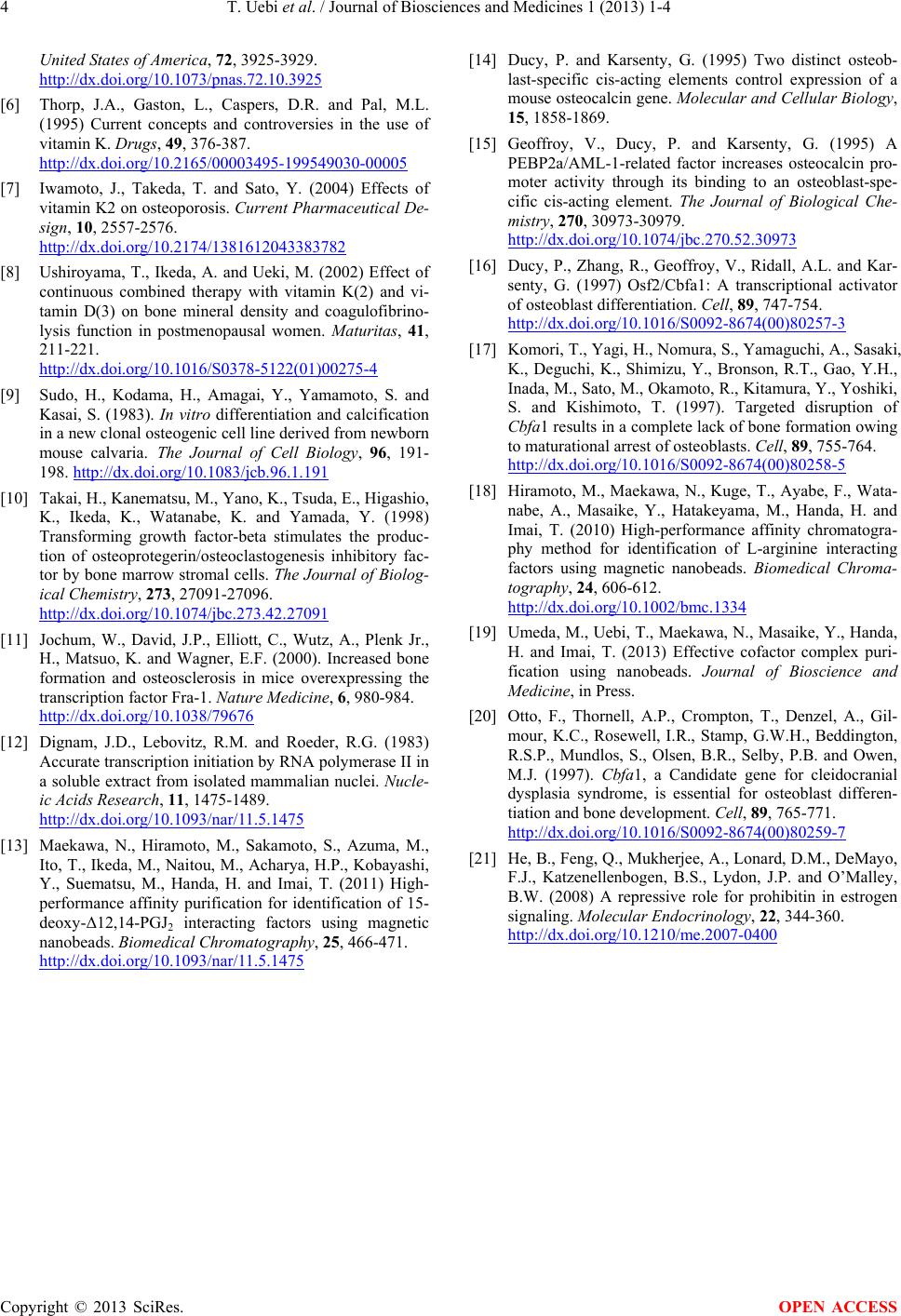
T. Uebi et al. / Journal of Biosciences and Medicines 1 (2013) 1-4
Copyright © 2013 SciRes. OPEN ACCESS
United States of America, 72, 3925-3929.
http://dx.doi.org/10.1073/pnas.72.10.3925
[6] Thorp, J.A., Gaston, L., Caspers, D.R. and Pal, M.L.
(1995) Current concepts and controversies in the use of
vitamin K. Drugs, 49, 376-387.
http://dx.doi.org/10.2165/00003495-199549030-00005
[7] Iwamoto, J., Takeda, T. and Sato, Y. (2004) Effects of
vitamin K2 on osteoporosis. Current Pharmaceutical De-
sign, 10, 2557-2576.
http://dx.doi.org/10.2174/1381612043383782
[8] Ushiroyama, T., Ikeda, A. and Ueki, M. (2002) Effect of
continuous combined therapy with vitamin K(2) and vi-
tamin D(3) on bone mineral density and coagulofibrino-
lysis function in postmenopausal women. Maturitas, 41,
211-221.
http://dx.doi.org/10.1016/S0378-5122(01)00275-4
[9] Sudo, H., Kodama, H., Amagai, Y., Yamamoto, S. and
Kasai, S. (1983). In vitro differentiation and calcification
in a new clonal osteogenic cell line derived from newborn
mouse calvaria. The Journal of Cell Biology, 96, 191-
198. http://dx.doi.org/10.1083/jcb.96.1.191
[10] Takai, H., Kanematsu, M., Yano, K., Tsuda, E., Higashio ,
K., Ikeda, K., Watanabe, K. and Yamada, Y. (1998)
Transforming growth factor-beta stimulates the produc-
tion of osteoprotegerin/osteoclastogenesis inhibitory fac-
tor by bone marrow stromal cells. The Journal of Biolog-
ical Chemistry , 273, 27091-27096.
http://dx.doi.org/10.1074/jbc.273.42.27091
[11] Jochum, W., David, J.P., Elliott, C., Wutz, A., Plenk Jr.,
H., Matsuo, K. and Wagner, E.F. (2000). Increased bone
formation and osteosclerosis in mice overexpressing the
transcription factor Fra-1. Nature Medicine, 6, 980-984.
http://dx.doi.org/10.1038/79676
[12] Dignam, J.D., Lebovitz, R.M. and Roeder, R.G. (1983)
Accurate transcription initiation by RNA polymerase II in
a soluble extract from isolated mammalian nuclei. Nucle-
ic Acids Research, 11, 1475-1489.
http://dx.doi.org/10.1093/nar/11.5.1475
[13] Maekawa, N., Hiramoto, M., Sakamoto, S., Azuma, M.,
Ito, T., Ikeda, M., Naitou, M., Acharya, H.P., Kobayashi,
Y., Suematsu, M., Handa, H. and Imai, T. (2011) High-
performance affinity purification for identification of 15-
deoxy-Δ12,14-PGJ2 interacting factors using magnetic
nanobeads. Biomedical Chromatography, 25, 466-471.
http://dx.doi.org/10.1093/nar/11.5.1475
[14] Ducy, P. and Karsenty, G. (1995) Two distinct osteob-
last-specific cis-acting elements control expression of a
mouse osteocalcin gene. Molecular and Cellular Biology,
15, 1858-1869.
[15] Geoffroy, V., Ducy, P. and Karsenty, G. (1995) A
PEBP2a/AML -1-related factor increases osteocalcin pro-
moter activity through its binding to an osteoblast-spe-
cific cis-acting element. The Journal of Biological Che-
mistry, 270, 30973-30979.
http://dx.doi.org/10.1074/jbc.270.52.30973
[16] Ducy, P., Zhang, R., Geoffroy, V., Ridall, A.L. and Kar-
senty, G. (1997) Osf2/Cbfa1: A transcriptional activator
of osteoblast differentiation. Cell, 89, 747-754.
http://dx.doi.org/10.1016/S0092-8674(00)80257-3
[17] Komori, T., Ya gi, H., Nomura, S., Yamaguchi, A., Sasaki,
K., Deguchi, K., Shimizu, Y., Bronson, R.T., Gao, Y.H.,
Inada, M., Sato, M., Okamoto, R., Kitamura, Y., Yos hiki,
S. and Kishimoto, T. (1997). Targeted disruption of
Cbfa1 re sults in a complete lack of bone formation owing
to maturational arrest of osteoblasts. Cell, 89, 755-764.
http://dx.doi.org/10.1016/S0092-8674(00)80258-5
[18] Hiramoto, M., Maekawa, N., Kuge, T., Ayabe, F., Wata-
nabe, A., Masaike, Y., Hatakeyama, M., Handa, H. and
Imai, T. (2010) High-performance affinity chromatogra-
phy method for identification of L-arginine interacting
factors using magnetic nanobeads. Biomedical Chroma-
tography, 24, 606-612.
http://dx.doi.org/10.1002/bmc.1334
[19] Umeda, M., Uebi, T., Maekawa, N., Masaike, Y., Handa,
H. and Imai, T. (2013) Effective cofactor complex puri-
fication using nanobeads. Journal of Bioscience and
Medicine, in Press .
[20] Otto, F., Thornell, A.P., Crompton, T., Denzel, A., Gil-
mour, K.C., Rosewell, I.R., Stamp, G.W.H., Beddington,
R.S.P., Mundlos, S., Olsen, B.R., Selby, P.B. and Owen,
M.J. (1997). Cbfa1, a Candidate gene for cleidocranial
dysplasia syndrome, is essential for osteoblast differen-
tiation and bone development. Cell, 89, 765-771.
http://dx.doi.org/10.1016/S0092-8674(00)80259-7
[21] He, B., Feng, Q., Mukherjee, A., Lonard, D.M., DeMayo,
F.J., Katzenellenbogen, B.S., Lydon, J.P. and O’Ma l ley,
B.W. (2008) A repressive role for prohibitin in estrogen
signaling. Molecular Endocrinology, 22, 344-360.
http://dx.doi.org/10.1210/me.2007-0400